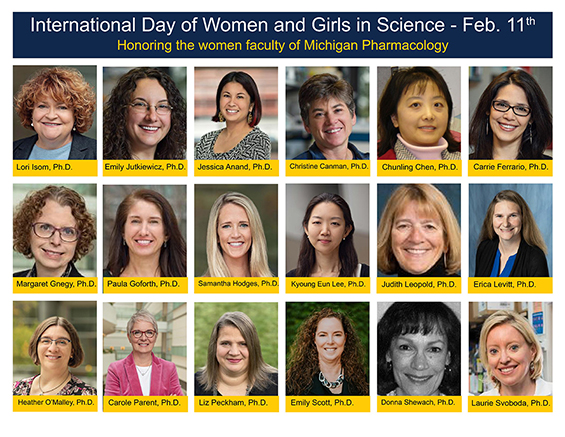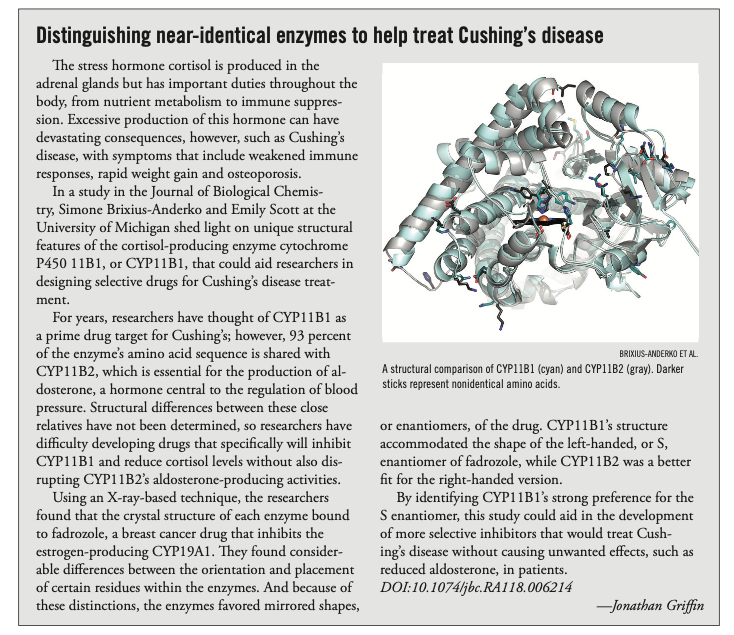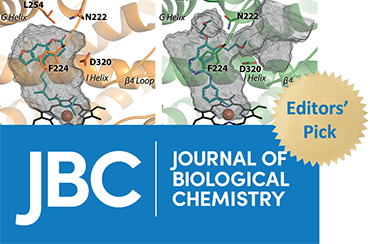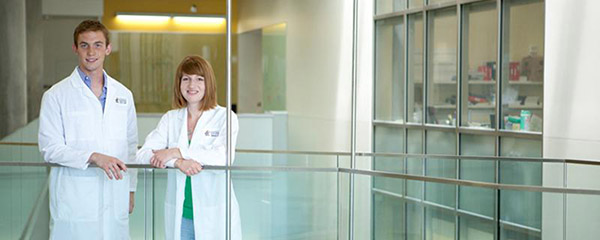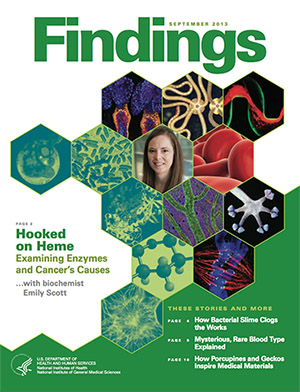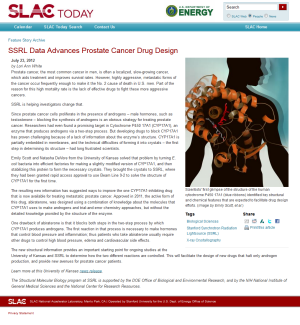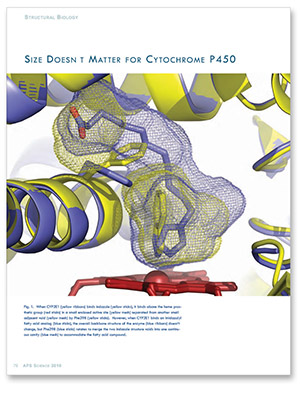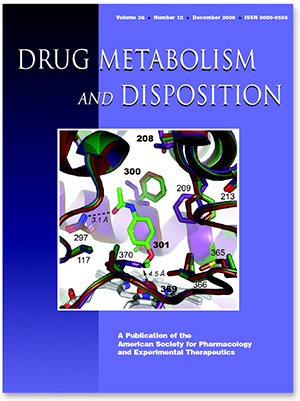Press Items
Scott featured in NIGMS's Biomedical Beat Blog
Out of the blue I recently got an email from Rachel Crowley, who was a graduate student at a former institution. Rachel is now the Editor of NIH's Biomedical Beat Blog and was catching up with me about the evolution in our P450 research since it was featured back in 2013. The 2023 interview is featured in the 10th anniversary edition .
Read the full article...
Dr. Emily Scott selected as ASPET Fellow
ASPET recently announced that Dr. Emily Scott was selected as a 2022 Fellow, an honor for our most distinguished members. Selection as a fellow of the American Society for Pharmacology and Experimental Therapeutics (FASPET) is an honor bestowed on ASPET members who have demonstrated excellence via their overall contributions to pharmacology and the Society.
Read the full article...
CYP8B1 structure paper selected as JBC Editor's Pick
Graduate student Jinghan Liu generated the first structure of human CYP8B1, a key enzyme involved in the production of bile acids and a potential drug target for type 2 diabetes and non-alcoholic fatty liver disease. Publication of this work was selected as an "Editor's Pick" article in the Journal of Biological Chemistry.
Read the full article...
Dr. Scott named F. F. Blicke Collegiate Professor of Pharmacy
The University of Michigan College of Pharmacy has named Dr. Emily Scott as the next F. F. Blicke Collegiate Professor of Pharmacy. This Professorship was established in 2008 to honor Professor Fredrick Franklin Blicke, a UM Medicinal Chemistry faculty member whose research and educational contributions had a considerable impact on the field. Professor Blicke passed away in 1968. Dr. Scott's research in the field of cytochrome P450 drug metabolism and drug targets is very well known and highly funded by NIH.
Read the full article...
Dr. Emily Scott elected AAAS Fellow
Dr. Emily Scott was elected as a 2019 fellow of the American Association for the Advancement of Science. Dr. Scott was recognized for distinguished contributions to the field of structural and functional studies on cytochrome P450s with the goal of understanding human drug metabolism by these enzymes. She is Professor of Medicinal Chemistry in the College of Pharmacy, Professor of Pharmacology and Biological Chemistry in the Medical School, and Professor of Biophysics in the College of Literature, Science, and the Arts.
Read the full article...
American Heart Association Fellowship
Scott Lab postdoctoral Fellow Simone Brixius-Anderko has been awarded an American Heart Association Fellowship to study the human enzyme cytochrome P450 11B2 and its production of aldosterone, which controls blood pressure.
Read the full article...
CYP11B1 structure highlighted in ASBMB Today
ASBMB Today highlighted a JBC paper by Scott lab postdoctoral fellow Simone Brixius-Anderko determining the first structure of CYP11B1. This enzyme produces cortisol, controlling various stress and immune responses, and is a target for the treatment of Cushing's Disease.
Read the full article...
CYP11B1 STRUCTURE SELECTED AS JBC "RECOMMENDED READ"
Postdoctoral Fellow Simone Brixius-Anderko's manuscript descirbint the first structure of cytochrome P450 11B1 was selected as a Recommended Read by the Journal of Biological Chemistry. Read the full article...
Read the full article...
Aaron Bart's manuscript selected as a JBC Editor's Pick
Graduate student Aaron Bart (Biophysics) recently published two new structures of human CYP1A1 with the grapefruit juice compound bergamottin and the cancer drug erlotinib in the Journal of Biological Chemistry. This paper was selected as one of JBC's Editors' Pick. This places Aaron's paper in the top 2% of JBC manuscripts. Aaron's author profile is here.
Read the full article...
NIH MERIT Award
In recognition of outstanding research, the National Institutes of Health’s National Institute of General Medical Sciences has awarded Dr. Scott research support up to 10 years in the form of a MERIT award. It’s a rare and important recognition. Researchers can receive them only once in a career and must have made highly valuable contributions over at least 10 years of previous NIGMS-funded research and Dr. Scott started her research career only 11 years ago.
Read the full article...
Cancer, Interrupted
Graduate students at the University of Kansas are uncovering new ways to more effectively treat cancer. Elyse Petrunak and Charlie Fehl, graduate students in medicinal chemistry at KU, are researching a specific enzyme, cytochrome P450 17A1, or CYP17A1, and its role in treatment of prostate cancer, the second-leading cause of cancer-related deaths in men.
Read the full article...
Timer Warner: Segment on Prostate Cancer Drug Research in Scott and Aubé Labs
Cable television highlighted research in the Scott and Aubé labs looking to improve the prostate cancer drug abiraterone. Graduate students Charlie Fehl and Elyse Petrunak are working to design and test new compounds that will treat prostate cancer by halting production of steroid hormones like testosterone, while reducing undesirable side effects such as elevated blood pressure.
Watch the video...
Hooked on Heme: Examining Enzymes and Cancer's Causes
Emily Scott's studies of cytochrome P450 enzymes involved in various types of cancers and in clearing foreign chemicals from the human body began with studies in starfish off the Gulf Coast. Read the full article...
Emily Scott: Enzyme Explorer
When she was an undergraduate studying marine biology at Texas A&M University at Galveston, Emily Scott received a late-night phone call from her professor. A bunk had become available on a research boat bound for oxygen-depleted “dead zones” in the Gulf of Mexico, but it was leaving the next day. Scott jumped at the chance. Despite battling seasickness as she took course exams on board the ship, Scott enjoyed her first taste of hands-on science. “I was hooked, and I went back every chance I got,” she says.
Read the full article...
Follow Your Passion
Following receipt of the North American New Investigator Award in honor of James R. Gillette, a profile of Emily Scott's career appeared in the ISSX Newsletter.
Read the full article...
SSRL Data Advances Prostate Cancer Drug Design
CYP17A1 is partially embedded in membranes, and the technical difficulties of forming it into crystals – the first step in determining its structure – had long frustrated scientists. Emily Scott and Natasha DeVore from the University of Kansas solved that problem by turning E. coli bacteria into efficient factories for making a slightly modified version of CYP17A1, and then stabilizing this protein to form the necessary crystals. They brought the crystals to SSRL, where they had been granted rapid access approval to use Beam Line 9-2 to solve the structure of CYP17A1 for the first time. Read the full article...
Prostate Cancer Target Analyzed
To understand better how two new anti- cancer agents work, researchers have obtained the first X-ray structures of a key cytochrome P450 enzyme to which they bind. Understanding how the drugs inhibit the enzyme could aid the design of more effective medications for prostate and breast cancer with fewer side effects.
Read the full article...
ASPET Drug Metabolism Division Early Career Achievement Award
Following receipt of the 2011 Early Career Achievement Award, a brief profile of Dr. Scott's studies and award lecture was highlighted on the ASPET website.
Read the full article...
Research highlight at Advanced Photon Source
The Annual Report of the Advanced Photo Source highlighted our research on cytochrome P450 2E1 structures that revealed very different active site topographies for complexes with low molecular weight compounds (yellow) and fatty acid analogs (purple). Read the full article...
Enzymes Key to Fighting Lung Cancer
Emily Scott, assistant professor of medicinal chemistry at the University of Kansas, was recently awarded a $300,000 grant from the American Recovery and Reinvestment Act for her innovative research in the fight against lung cancer. Watch the video...
Cover of Drug Metabolism and Disposition
A set of X-ray structures of cytochrome P450 2A6, 2A13, and a quadruple 2A6 mutant all with phenacetin make the cover of Drug Metabolism and Disposition.
Read the full article...


